Exactly 55 years ago today, NASA astronauts Neil Armstrong, Buzz Aldrin, and Michael Collins arrived at historic Launch Complex 39A, rode an elevator to the top of their Saturn V rocket, and strapped into the confines of the Command Module Columbia. Just under three hours later, the towering booster’s five F-1 engines ignited, lifting it ponderously off the launch pad. The expendable Saturn V would complete its job within 12 minutes, but its brief service would be remembered forever as the beginning of one of the most important voyages of exploration in human history.
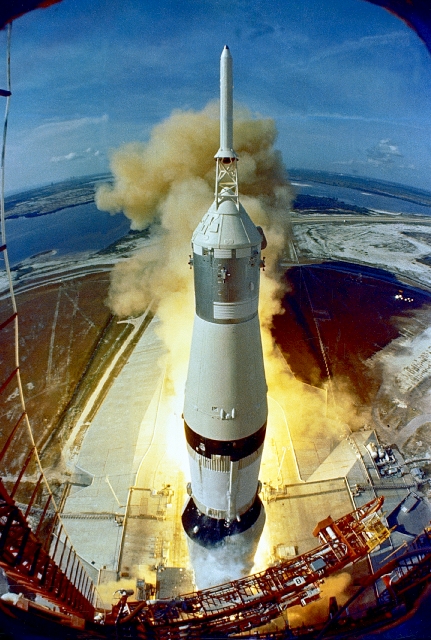
Much to the chagrin of the engineers who built the Saturn V, the first six lunar landings were followed by a five-decade hiatus. However, NASA is now entering the home stretch of preparations for a new generation of lunar missions. The space agency marked the anniversary of Apollo 11 by rolling out the Core Stage of the Space Launch System (SLS) rocket for Artemis 2, the first of what will hopefully be many new Moonshots. This stage is the first SLS intended for crewed flight, and it will be the first rocket of any type to send astronauts beyond Low Earth Orbit since 1972. It is fitting that the Core Stage’s departure was witnessed by the astronauts who will ride it to orbit at the same factory which assembled the stages of the Saturn V.

The rollout of the stage, known as Core Stage-2 by its designers, is the culmination of years of work by the engineers at NASA’s Michoud Assembly Facility (MAF). In the past, NASA officials have compared the assembly of SLS Core Stages to the construction of naval capital ships, such as aircraft carriers and battleships. Both vehicles are expensive, handcrafted, and fill unique roles in the fleets of their owners which could not be satisfied with preexisting solutions. Along with SpaceX’s Falcon 9 and ULA’s Atlas V, the SLS is one of the only American rockets with sufficient reliability to be human-rated. At the same time, it must also have the thrust and efficiency required to send astronauts to the Moon in one launch.

SLS inherits some components – particularly its propulsion systems – from the Space Shuttle, which was the most complex machine ever built at the time. The Core Stage is similarly elaborate, as it must fulfill the roles of the capacious propellant tanks in the Shuttle’s External Tank, the labyrinth of plumbing in the Orbiter’s engine section, and the flight computers in the Saturn V’s instrument ring. This complexity, as well as the extensive quality control requirements imposed by the demands of human spaceflight, accounts for the long lead time required to build an SLS vehicle. From the fabrication of the first components to the rollout, it took NASA seven years to build Core Stage-2.
The construction of the stage began in 2017 with the fabrication of basic components, such as barrel rings, tank domes, and avionics. The rings were then welded together into complete propellant tanks using an innovative technique called friction stir welding. This method decreases the mass and increases the strength of welds. Multiple companies have licensed the technology, making it the most important industrial spin-off from the Artemis program to date. Each section of the 27.5-foot-wide (8.4-meter) stage was welded together inside the state-of-the-art Vertical Assembly Center, the largest welding tool in the world.

The Core Stage consists of five distinct elements: the liquid oxygen and liquid hydrogen propellant tanks, a reinforced interstage which connects them, a forward skirt which houses SLS’ flight computers, and the engine section at the base of the rocket. All of these elements were built over the course of 2018 and 2019. The hydrogen and oxygen tanks were then tested for leaks, outfitted with their internal plumbing and electrical lines, and coated in a layer of foam insulation, which gives the stage its iconic orange color.
Meanwhile, the MAF engineers began the laborious process of installing plumbing into the engine section. This was a time-consuming procedure, as an impromptu clean room had to be built around the engine section and swept clean of dust and debris prior to the installation of any piece of hardware in the propulsion system. The clean room then had to be broken down to lift a new component into the section. For this reason, NASA is moving the final assembly of the engine section to the Kennedy Space Center, beginning with Artemis 3.
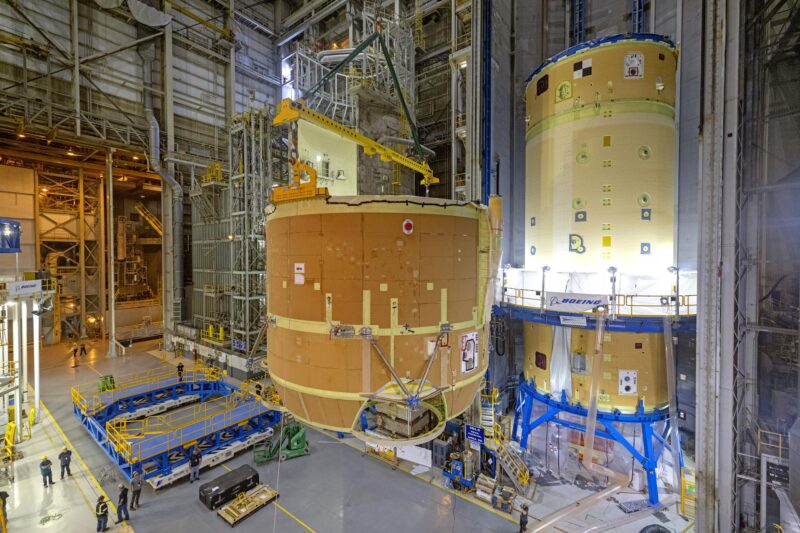
The forward skirt, the liquid oxygen tank, and the interstage were then welded together inside the Vertical Assembly Center over the spring of 2021. This process is known as the Forward Join. The integrated oxidizer tank and adapters were then rotated to a horizontal position and mated with the massive hydrogen tank on March 18th, 2022. The engine section followed one year later. The team was making excellent progress towards shipping the stage to the Kennedy Space Center in the summer. However, lingering supply chain issues from the COVID-19 pandemic derailed this plan. A shipment of downcomers, propellant lines which feed liquid oxygen from its storage tank to the engine section, was delayed. As a result, NASA reassigned some of its technicians to the Core Stages for future Artemis missions. Just one shift of employees worked on Artemis 2’s stage over the summer, as there was little work left to do [1].
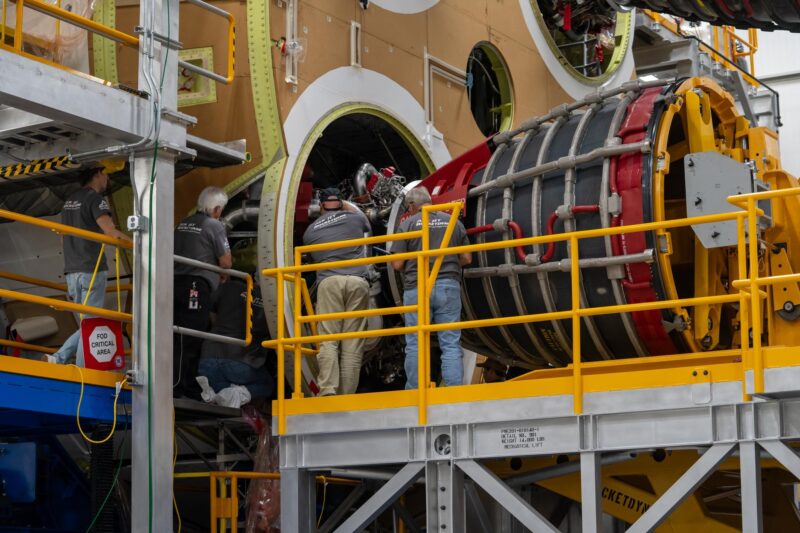
Once the downcomers were finally available, the SLS team installed the four RS-25 main engines last November. The liquid hydrogen-powered RS-25 is the most efficient rocket engine in service. It is also one of the most reliable; during 135 Shuttle missions, only one RS-25 failed during flight, and that engine shut down due to a sensor error rather than to a problem with the engine itself. When the Shuttles were sent to museums in 2012, they were outfitted with detailed RS-25 replicas in place of their actual main engines. One of the engines powering Artemis 2 was used on 15 flights and was taken from Endeavour. Another flew five missions and was taken from Atlantis. The remaining two engines were built from scratch to support the Artemis program.

The completed Core Stage is 212 feet long. Once its 27-foot-tall interstage adapter is attached in Florida, the Core Stage will be the longest single-element rocket stage in the world (though not the most powerful; that honor belongs to SpaceX’s Super Heavy booster). SLS journalist Philip Sloss recently produced an excellent video on the assembly process, which includes exclusive photos of Core Stage-2 components under construction [2].
NASA put Core Stage-2’s hardware and software through their paces during a series of Integrated Functional Tests in January. It passed with flying colors, and was then placed into storage. While the stage was undergoing its final testing, NASA announced a 10-month delay to the Artemis 2 mission due to issues with the Orion spacecraft’s heat shield, life support system, and batteries. NASA decided that it was preferable to store the Core Stage in place at MAF rather than inside KSC’s Vehicle Assembly Building.

Today, Artemis 2’s Core Stage moved out of limbo and began its 900-mile journey to Florida. The stage’s departure was preceded by the removal of three levels of scaffolding, which allow MAF employees to perform work on its entire outer hull. It was then towed to Building 110, another facility on the MAF campus, for final preparations prior to shipping. By carefully maneuvering the stage to place a support beam in between the RS-25 engines, the SLS team was able to clear enough space to install a protective cover on the front of the stage to protect its interior from the elements [3].
The Core Stage was gingerly placed onto two customized support cradles. One was attached to the engine section, while the other was attached to the interstage. Each cradle, in turn, was carried by a pair of Self-Propelled Modular Transporters (SPMTs). These remotely-driven robotic vehicles each have 24 wheels and an adjustable flatbed, which allows them to keep the Core Stage perfectly level regardless of any changes in slope.
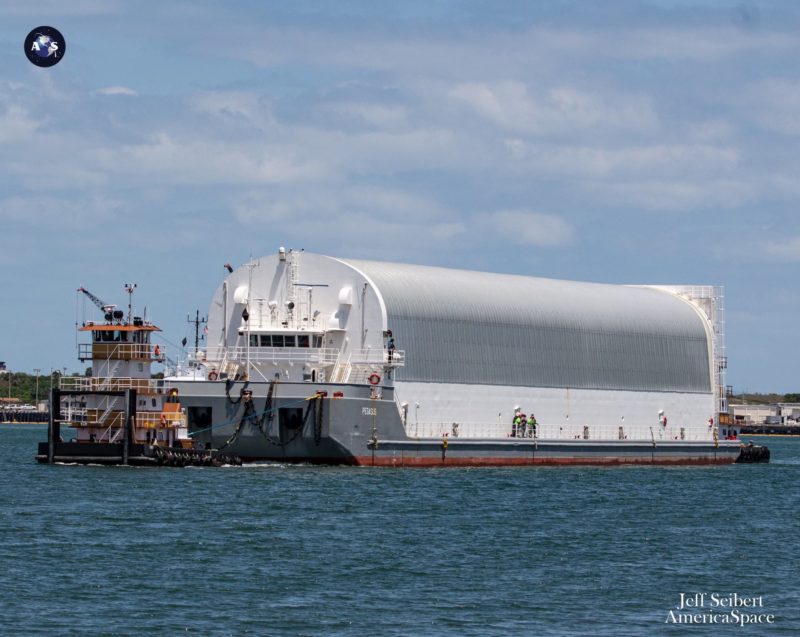
The SPMTs, with the Artemis 2 Core Stage in tow, departed MAF in the morning. Travelling down Saturn Boulevard, the stage covered the 1.3 miles (2.1 kilometers) between the factory and the local shipping dock at a pace of 0.7 miles per hour. It arrived at the dock after a journey of approximately two hours. Once there, the SPMTs drove directly onto NASA’s Pegasus barge. The distinctive 310-foot-long floating platform, which is responsible for carrying most SLS components from their manufacturers to KSC, recently completed a series of its own upgrades. The stage was anchored to several large pedestals, which will keep it sturdy in choppy seas.
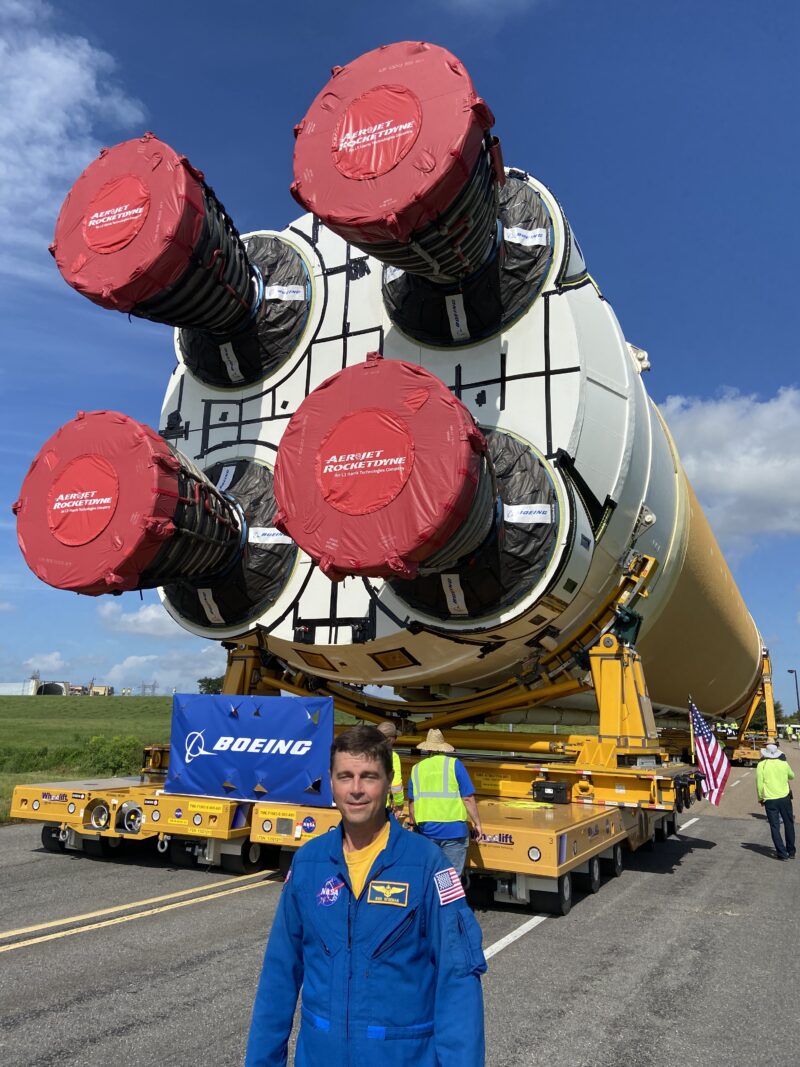
The Core Stage was escorted to the dock by two of the four astronauts who will eventually ride it to orbit. “Next stop: (The Kennedy Space Center) and then on to the Moon!”, mission commander Reid Wiseman exclaimed [5]. Canadian Mission Specialist Jeremy Hansen added, “Watching the Core Stage of the Artemis II SLS rocket roll out of (Michoud) with (Reid) today gave me chills (despite the Louisiana heat!)” [6]. The presence of the two explorers underscored the fact that this will be the first SLS to be entrusted with human lives – stakes which are viewed with the utmost importance by the men and women who poured years of their lives into the machine.
The Artemis 2 Core Stage now begins its long journey to its launch site. The trip by sea should take approximately six days. After it arrives, the pace of activities at the Kennedy Space Center should pick up considerably as NASA begins to stack Artemis 2’s SLS rocket in the fall or the winter. The commencement of stacking will be a strong indication that NASA feels comfortable with launching the 21st Century’s first piloted lunar mission as early as September of 2025.
Missions » SLS » Missions » SLS » Artemis »
Posts associated with the SLS missions
